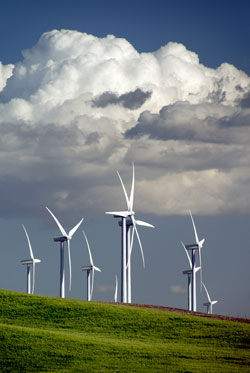Pacific Southwest, Region 9
Serving: Arizona, California, Hawaii, Nevada, Pacific Islands, Tribal Nations
Region 9 Strategic Plan, 2011-14
Clean Energy and Climate Change
In addition to GHG emission reduction benefits, there are multiple environmental and public health benefits to reducing energy consumption and promoting renewable energy. Impacts are associated with each major step in utilizing fossil fuel: oil and gas extraction, coal mining, electricity generation, petroleum refining, fuel transport and storage, and fuel combustion. Similarly, accidental oil spills and explosive conditions in mines can create large-scale environmental and public health risks.
We will work through voluntary and regulatory programs with partners (local governments, states, industry, federal agencies) and internally to reduce GHG emissions in the Region 17% below 2005 levels by 2020, and 83% below 2005 levels by 2050. Reductions of this magnitude will require the commitment of partner entities throughout Region 9. Internal activities to ensure that Region 9’s operations achieve carbon neutrality by 2012 and to help meet Agency-wide goals under the President’s order on Federal Leadership in (Executive Order 13514) are also part of this reduction.
Region 9’s more significant work activities to support our partners and achieve these goals are summarized below.
Transportation
The transportation sector was responsible for 39% of GHG emissions in Region 9 in 2005. To achieve our goals, we will work to reduce greenhouse gas and black carbon emissions through support for deployment of electric vehicles; smart growth principles; California Statewide High Speed Rail planning; West Coast Collaborative diesel grants, engine efficiencies and fuel improvements.
Energy
Meeting the region’s 2005 energy needs accounted for 36% of GHG emissions. To achieve our GHG reduction goals, we will promote cost-effective energy efficiency (EE) measures and environmentally responsible renewable energy (RE) development.

- Energy Star: Support the national Energy Star program by promoting benchmarking, energy efficiency, and the use of Energy Star products. Encourage building owners/managers to benchmark their energy use through Energy Star’s on-line database called Portfolio Manager. Continue to incorporate Energy Star into the Green Building effort.
- Promote water efficiency, water reuse, energy efficiency and renewable power generation in the Water Sector. Saving water saves energy and thereby reduces GHG and other air emissions. Approximately 11.4 billion kilowatt hours are used annually to pump and treat water within the region and a 20% savings through energy and water efficiency is realistically achievable. To achieve these savings, the Region will work with partners to identify energy efficiency and renewable energy potential at drinking water and wastewater facilities, work with utilities to implement feasible options, and work with agricultural producers to improve water use efficiency.
- Support development of climate action plans for the Mexican states of Baja California and Sonora, implementing Border 2012's newly developed Clean Energy and Climate Change objective. The Climate Action Plans provide the framework for future investment in renewable energy and energy efficiency projects benefitting the public health of both U.S. and Mexican citizens.
- Through the Guam Energy Task Force and the Civil Military Coordination Council, Region 9 will work with the Department of Defense, the National Renewable Energy Laboratory, and the Government of Guam to ensure that new power demand for military expansion is met primarily through improvements in energy efficiency and renewable energy to help achieve DoD's goal of reducing greenhouse gas emissions by 34%.
- Evaluate and implement lower carbon footprint technologies, such as in-situ treatment solutions. Promote the RE-Powering America’s Lands project for constructing utility scale renewable energy projects on contaminated lands, including former mine sites, Superfund sites, and active and closing federal facilities.
- In partnership with DOE's National Renewable Energy Laboratory and the City of Richmond, California develop a screening tool that the City can use to prioritize the best sites for renewable energy systems on degraded or contaminated land in the community. Connect with EPA's RE-Power America Program to make the tool more widely accessible to other cities.
- Promote the capture and utilization of biogas for renewable energy production. Major biogas sources include: dairies, landfills and wastewater treatment facilities. Capturing the biogas reduces emissions of methane, a potent GHG; while utilizing the biogas to produce energy reduces the need for fossil-fuel derived energy.
Industry
- The industrial sector emitted 18% of the regional GHGs in 2005. To help reduce emissions from this sector, the Region proposes to:
- Provide outreach and technical assistance to achieve voluntary reductions from the highest GHG emitting industrial sectors including recruitment of new members into EPA partnerships with a proven track record of reducing GHG emissions. Partnership programs include: Landfill Methane Outreach Program, GreenChill, Responsible Appliance Disposal Program, Green Power Partnership, and Combined Heat and Power Partnership. In areas where we are the permitting authority, process permit applications for greenhouse gas permits, and ensure compliance with the GHG Reporting program for large industrial operations.
| Pacific Southwest NewsroomPacific Southwest Programs | Grants & FundingUS-Mexico Border | Media CenterCareers | About EPA Region 9 (Pacific Southwest)A-Z Index |
